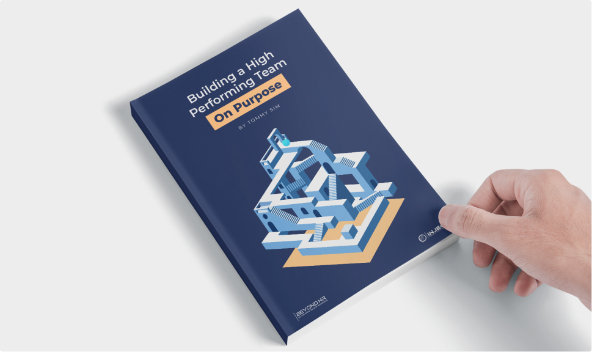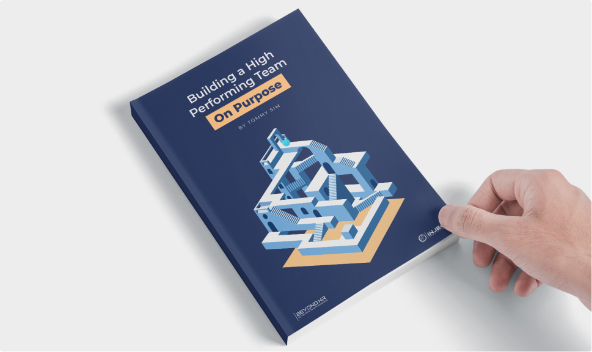This is Chapter 2 in the 8 part self-guided series, Building A High Performing Team On Purpose.
There is a scene in Seinfeld where Jerry and George talk about how people like to say “salsa”.
In business, “strategic” and “strategy” are in the same bucket. A lot of businesses believe they have a strategy. Most management teams use this term loosely and will reference their plans or a set of initiatives designed to improve the business as their strategy. They may describe “strategic goals” as achieving 20% growth year on year or similar generic outcomes. It is usually when they are talking about improving a part of the business, but this doesn’t mean they are working on a strategy. It could just be an operational improvement, which can be valuable but is not a strategy.
It’s important to get the language right because this reduces the chance that we are kidding ourselves and confusing others. One of the simplest definitions of business strategy is “where you are going to play and how you are going to win?”. What I believe is just as important is where you are not going to play and what is not going be pivotal to winning.
I’m not going to go into too much depth about strategy here, because there is a lot that would need to be written and that’s a different topic. However, strategy in building a high performing team on purpose is highly relevant. This is for three distinct reasons:
- If you have the discipline to say what you are not, then you have a better chance of being what you want to be
- If you only deal with customers who value what you do, then the measures of success will be aligned to your strengths
- If your organisational design is aligned to your strategy, then the trade-offs will allow you to have better talent in pivotal areas
I’ll explain this as we work through this chapter.
1. If you have the discipline to say what you are not, then you have a better chance of being what you want to be.
Defining what you are not is more powerful than defining what you are. Companies will often talk about being the best such-and-such company in the world. For instance, we are going to be the best motor vehicle company in the world! What does that actually mean? That’s like being the best runner in the world. A sprinter is vastly different to a marathon runner. Running the steeple chase is different from the 100m hurdles. Rather than saying you are a 100m sprinter, say you are not a marathon runner.
It’s not about being generically better than everyone, it’s about being specifically better in a specific way to a specific group of people.
There is a very simple exercise that I conduct with business leaders in order to get the discussion going on strategy. It goes like this:
You have three areas of focus below:
- Operational Excellence: How consistently your processes deliver your product or service to your customers.
- Customer Intimacy: How much you know the intricacies of each customer and deliver value to their specific needs.
- Product Innovation: How innovative your products or services are when compared to the rest of the market.
You have 11 points to allocate based on what you want your business to be best at.
For example, you could go:
- 3 on Operational Excellence
- 5 on Customer Intimacy
- 3 on Product Innovation
This means that your execution and products are at the standard of the industry, but you are highly tailored in your approach to meet the specific needs of customers. If you switched the 5 from Customer Intimacy to Operational Excellence, you would then be reducing your tailoring to lead the industry in excellent delivery.
So, what do you choose? If you have several business partners, it would be worthwhile completing the exercise separately and then comparing notes.
There are many models and to develop a proper strategy you need to go much deeper than this. Completing this exercise doesn’t mean you have a strategy. It is a simple way to look at what you are not going to be.
The message is to define what you are not and have the discipline to apply this. This gives you a better chance of being what you want to be.
2. If you only deal with customers who value what you do, then the measures of success will be aligned to your strengths
Another simple exercise I like to perform is to draw a picture of your target customer – down to the level of detail of what they had for breakfast. Now do the same with your “enemy” customers who kind of look like your target market but give you a world of headaches. What your target customer value should align to is what you are striving to be best at. What your enemy customers value should be irrelevant. Energy trying to please your enemy customers takes away from building capability to serve your target customers.
Some of you might be nodding your head right now but are wondering how this relates directly to building a high performing team? Well, the first is that a high performing team is a generic term that needs to be applied to the specific. A high performing team in what? Basketball? Football? Even within the same sport, is it a run and gun team who plays at a fast pace or is it a team that has strengths in hustle and defence. Whilst all teams need to be somewhat proficient in everything, the better teams are outstanding in one or two areas and all players are geared towards this strategy.
Transferring this across to business, if you have a team who are all great at selling high value products and deeply understanding customer needs and if you have processes that are set up to deliver to the high end market, then if you take on a lot of low margin high volume deals then this is likely to cause stress and frustration for your team and not play to their strengths.
Who likes doing their best and finding that no matter what they do, they can’t seem to win? Well, not many people I would think, but certainly not high performers. High performers cannot stand to be in a position where they are not able to be a high performer no matter what they do. Those people will become disengaged and eventually leave.
If your strategy is not clear and/or you are not disciplined enough to focus on your target market, then you will have dilution. If your business is diluted across a broad range of customers that includes your enemy customers, your people will be feeling increased stress dealing with unhappy people.
Here is the kicker:
One thing that causes stress for your people is dealing with unhappy customers. Who likes dealing with people telling you that you stuffed up? That you are no good? The additional re-work that takes place also causes stress, because people are working longer hours and working on things that sap their energy. The role that they signed up for may not be the role they want. Fixing the issues may also not be their strength, as opposed to delivering value to your target market.
The stress that this creates for your employees will build tension between them and your managers. If your managers feel powerless to change it, they will become disengaged. Your business will be less profitable, and you will not be motivated to invest in sourcing more business in your target market because you’ll be busy putting out the fires caused by your current unhappy customers and employees.
Conversely…
If you are delivering value to your target market and not trying to please your enemy customers, you have a competitive advantage in attracting and retaining talent. You can offer talented employees an experience that is taking full advantage of their talents, without placing them in situations that highlight their weaknesses. You can offer an enjoyable workday filled with happy customers who love what they do. This is what a good Employee Value Proposition should always include, which I will touch on in later chapters.
Having a clear strategy that allows you to deal only with customers who value what you do, gives your people a better chance of being high performers and gives you a better chance of attracting and retaining high performers.
3. If your organisational design is aligned to your strategy, then the trade-offs will allow you to have better talent in pivotal areas
The first two concepts of this chapter are on having a clear strategy, focusing on delivering value to your target customers and avoiding your enemy customers. If you have bought into the concept of this being an important part of building a high performing team on purpose, then what are the steps you need to take to enable your team to deliver on this value?
Some of the questions worth asking to help define this are:
- What value do we want to provide for what type of customer? What is the pain we alleviate and why do they care?
- What does my business need to do specifically in order to deliver this value? What are the deliverables and in what way?
- What capability does my business need to have in order to achieve these deliverables?
- What part do my people play? What do my people need to be best at? What can I live with them not being best at? What do they not need to be good at at all?
- What are the positions that are going to be most pivotal in delivering my competitive advantage?
- What are the behaviours I am looking for in my people that helps them be the best at that thing? What do they need to know? What else do they need?
- How do they need to best work together? How do they best work with customers and suppliers?
To give you an example, I founded a recruitment company called Inject, which focuses on hiring talent with the right attitude, aptitude and behaviours. The target market is small-medium business owners who are challenging their industry or delivering a premium solution to their customers. The capability required is to have strengths in analysing people, thinking outside the box in terms of sourcing strategy and knowledge of what constitutes high performance.
There is zero requirement to be good at cold calling, as this is not what the business does at all. There is no requirement to be able to sell a candidate. There is a requirement to present a complete assessment of a candidate accurately and transparently. The way they need to best work with their customers to learn deeply about what it’s like to run a business and how the impact of one poor performer can bring down a small business. To properly empathise with the business owner and present information that gives them confidence there is an alignment.
The talent strategy at Inject is starkly different to most recruitment companies, therefore the target market for talent is completely different. What people are hired on, what they are trained on, what they are measured and rewarded on is completely different. There is no competition for talent because the overlap of what they do is so small. There is nothing particularly wrong with traditional recruitment companies, it’s just that there are thousands more like them.
Are you utilising your labour force in a way that creates an inimitable competitive advantage, or have you become much the same as everyone else?
The capability to deliver your strategy comes from your people. If you don’t have a clear strategy, then you are just trying to hire generally good employees. You aren’t looking for them to be great at a smaller number of things. Then if you place these people in situations where your company is not best at any of those things, then they are constantly dealing with unhappy customers. When you are dealing with angry people each day and feel powerless to do anything about it, you end up unhappy yourself and don’t deliver great service.
Your talent strategy also needs to be a “strategy” and that means trading off one thing for another. It’s not about generically good. Work out what you are turning up and what you are turning down, what you are investing in and what you are leaving to one side. Having a talent strategy that supports a business strategy gives you a much better chance of building a high performing team on purpose.
I recommend you take the following three actions:
- Clarify what your strategy is and make it crystal clear. Beware of confusing your strategy for your plans, initiatives and tactics. Be clear on the trade offs you are making.
- Be disciplined about who your customers are and as much as possible only deal with those who are truly in your target market and are equipped to serve. Doing so will set your employees up for success (subject to making sure the business operations are actually set up to properly deliver on your strategy).
- Build your organisational design off your strategy and by doing so define the capabilities you need to be great at to deliver your strategy (more on this in the next section).
You can read the first chapter of Building A High Performing Team on Purpose here.






